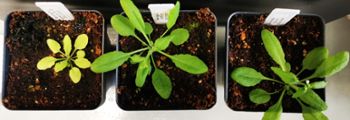Recently discovered protein enhances understanding of photosynthesis
MSU-DOE Plant Research Laboratory (PRL) scientists have published a new study that furthers our understanding of how plants make membranes in chloroplasts, the photosynthesis powerhouse.
The work focuses on RBL10, a rhomboid-like protein found in plant chloroplast membranes. Rhomboid-like proteins are well studied in many organisms, including bacteria, flies, and humans. But they are less understood in plants. They typically digest proteins.
In 2019, the lab of MSU Foundation Professor Christoph Benning at the PRL proposed that RBL10 helps produce the chloroplast lipid membranes. Lipids are molecules that make up membranes and the oils in living beings.
The current follow-up study reveals RBL10 interacts with other chloroplast proteins and teases how it might perform some of its functions. The study is published in The Plant Journal.
Following their hunch that RBL10 affects chloroplast lipids, the scientists found RBL10 in a large protein complex and searched for proteins it might interact with. Using a technique called co-immunoprecipitation, they isolated and fished out a group of proteins connected to RBL10.

“We expected their functions to be very simple and lipid related,” said Anastasiya Lavell, a former graduate student in the Benning lab and the first author on the study. “The profile of the proteins that we fished out is broader and more complicated than expected.”
Follow-up experiments showed that nine proteins seem to directly interact with RBL10. While two are related to lipid metabolism, the rest perform such functions as:
- repairing photosynthesis components;
- reacting to stress from excess exposure to light
- making carbohydrates, which plants use as fuel.
“Perhaps all these processes are connected, and RBL10 is at the nexus of this group,” Anastasiya said.
Focusing on the two lipid related proteins, Yang Xu, a coauthor on this study and a postdoctoral research associate in the Benning lab, explored mutants lacking these two lipid proteins which provided clues towards the role of RBL10 in making chloroplast membranes.

Credit: Yang Xu
“It is very intriguing to find that RBL10 may interact with two lipid players, which may link back to the observed lipid phenotype of the rbl10 mutant,” Yang said. “Moreover, the identified RBL10 interactome may suggest a complex spatial organization of lipid biosynthetic networks in chloroplasts.”
Moving forward, the Benning lab wants to drill deeper into the associations between RBL10 and the identified proteins. One in particular, ACP4, will be studied in detail. They will also examine how stable the protein complex is, if there are other interacting proteins they missed, and if RBL10 always works as part of a complex.
“It is a nice body of work, and I had a lot of help at the PRL,” Anastasiya said. “This is the first evidence that RBL10 is part of a complex. We still need to do more work to get to a full picture of what the complex looks like. However, we have begun to expand our understanding of these rhomboid-like proteins in plants.”
Additional authors on the study include: John Froehlich, Montgomery Smith, Christoph Benning, and Cameron De La Mora.
Banner image: Scientists in the MSU-DOE Plant Research Laboratory (PRL) have published a new study that furthers our understanding of how plants make membranes in chloroplasts, the photosynthesis powerhouse. Pictured above is a normal Arabidopsis plant (right) and lipid mutants (left, center) used by the researchers in their study. Credit: Yang Xu